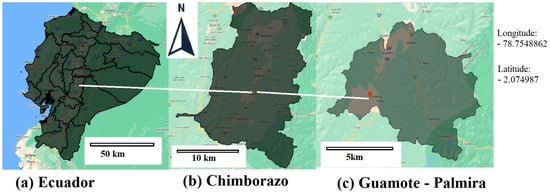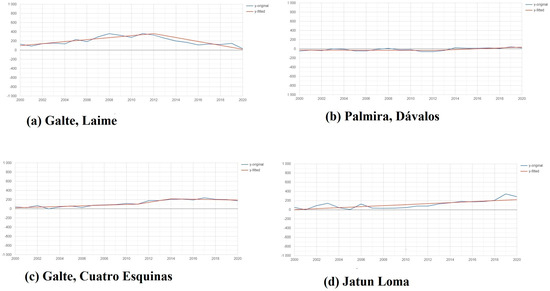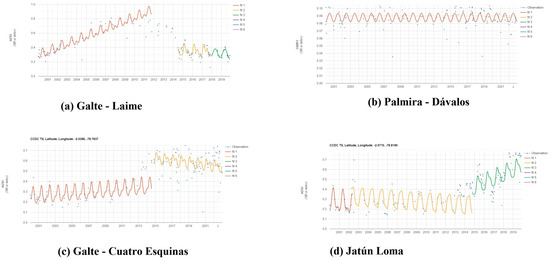Abstract
Deforestation is a significant global concern, as forests are vital for climate balance, water conservation, and rainfall. In Palmira, Chimborazo, Ecuador, a pattern of afforestation followed by deforestation has been observed, influenced by both public and private activities. Some areas, due to prolonged erosion, have even turned into deserts. This study utilized the Google Earth Engine platform and algorithms like LandTrendr and CCDC to analyze satellite imagery from 2000 to 2020, aiming to understand the forest dynamics in four specific Palmira locations. The results were consistent with documented patterns of afforestation and deforestation in the region. For instance, the Galte Laime area experienced an increase in forest cover until 2006, after which significant deforestation occurred. In contrast, Palmira Dávalos, often referred to as the Palmira Desert, consistently showed minimal vegetation, a result of centuries of erosion. Galte Cuatro Esquinas presented a decline in forest cover until 2009, after which regrowth was observed. Jatun Loma initially maintained its forest cover but eventually experienced deforestation, followed by a reforestation phase. In conclusion, this research offers a comprehensive insight into Palmira’s forest dynamics using advanced algorithms and satellite-based time series. The findings emphasize the importance of remote sensing tools in monitoring forest changes, which can be pivotal for informed decision making in forest management and conservation in the region.
1. Introduction
Forests are essential to global ecology, storing carbon, preventing droughts, promoting rainfall, and protecting water resources and soil [1,2,3,4,5].
Between 1990 and 2000, Ecuador lost approximately 198,000 hectares of natural forests annually, making it one of the Latin American countries with the highest deforestation rates [6]. From 2000 to 2008, Ecuador’s forested area decreased to 59%. However, between 2008 and 2018, there has been a significant recovery. Most deforested areas were converted into agricultural lands, with a smaller percentage used for infrastructure due to agricultural expansion and extensive shifts in land use [7].
In Palmira, Chimborazo district, there is a constant cycle of afforestation and deforestation due to agricultural expansion. Even though projects like PROFAFOR and the GAD of Guamote reforest the area, over time these same entities deforest it for economic gain. Species such as pines and eucalyptus have been planted, with community efforts involving various local entities and associations [8].
This study aims to identify disruptions in the altered forests of Palmira, whether caused by humans or natural factors. The objective is to model 20-year forest dynamics. Reference points include Jatun Loma, Galte Laime, Galte Cuatro Esquinas, and Palmira Dávalos in the “Palmira Desert”.
The aim of this research is to use the GEE platform and the LandTrendr and CCDC algorithms on Landsat images to describe the forest dynamics caused by deforestation, reforestation, and natural processes in the Palmira area, Chimborazo district, in Ecuador.
2. Materials and Methods
2.1. Study Area
The Palmira parish is located in Ecuador, specifically in Chimborazo, in the Guamote canton, at an altitude of 3280 m above sea level. Temperatures range from 12–13 °C and it has approximately 16,000 inhabitants, predominantly indigenous. Both Kichwa and Spanish are spoken. The primary economic activity of the region is agriculture, with the main crops being white onion, corn, and peas. This can be observed in Figure 1.

Figure 1.
Location of Palmira in the Guamote city, Ecuador.
2.2. Data
Landsat images of the Palmira parish were obtained through the GEE platform, spanning the years 2000 to 2020. Images from the Landsat 5 Thematic Mapper (TM), Landsat 7 Enhanced Thematic Mapper Plus (ETM+), and Landsat 8 Operation Land Imager (OLI) were used, creating a median dataset. These data have undergone atmospheric correction and include a mask for clouds, shadow, water, and snow, produced with [9].
Due to the differences in reflective wavelength between the TM/ETM+ and OLI sensors, the bands from Landsat 8 OLI were harmonized to their TM/ETM+ equivalents using the regression equations mentioned in [10].
2.3. Methodology
LandTrendr is a spatiotemporal algorithm used to detect changes in satellite image time series, primarily from Landsat. It extracts spectral change trajectories from the Earth’s surface [11], and is applied in areas including forest restoration [12], pest-induced tree mortality [13], forest cover trends, ancient settlement ID, abandoned land mapping, and biomass change assessments [14].
Its evaluation and construction used NDVI. LandTrendr’s spatial–temporal dynamics for pixel are depicted in illustration 2. This illustrates the main algorithm elements: event magnitudes and durations, disturbances, and stability, over 20 years.
After obtaining the dataset as described in the previous section, we proceed to adjust the LandTrendr’s parameters, which are detailed in Table 1 along with the values used in this study.

Table 1.
Description of LandTrendr algorithm parameters. Adapted from [15].
2.4. CCDC Algorithm
The CCDC algorithm is used for detecting land cover changes through satellite image series, it was initially developed in MatLab and then ported to Python, and recently integrated into the Google Earth Engine [16]. It utilizes Landsat data to detect fluctuations in spectral bands or indices like NDVI, EVI, and NBR. Changes can be seasonal or abrupt, such as deforestation and natural disasters. Functioning as a linear time series, it updates with new observations and employs a harmonic regression model to identify changes in pixel values. Breakpoints indicate shifts in spectral–temporal behavior due to coverage changes. Implemented in GEE, it is user-friendly and delivers good results using its default parameters, as shown in Table 2.

Table 2.
Description of the algorithm parameters of CCDC.
3. Results
As previously mentioned, four reference points were utilized, which are depicted in Figure 2. The exact coordinates of these locations are detailed in Table 3. The LandTrendr and CCDC algorithms detect disturbances, revealing their timing, magnitude, and duration. Disturbances primarily result from ongoing reforestation and deforestation by companies and residents, in collaboration with the government of Guamote.

Figure 2.
Satellite images of the geographical coordinates of areas in Palmira, Ecuador.

Table 3.
Geographical coordinates of the Palmira area, Ecuador.
As observed in Figure 3a and Figure 4a, both LandTrendr and CCDC exhibit similar patterns in the Galte Laime sector. A growth in the forested area is noticeable up to around the year 2006, after which it remains relatively stable until 2012 for LandTrendr and 2014 for CCDC. Subsequently, significant changes indicate a substantial deforestation event that continues to the present day.

Figure 3.
Disturbance trends using the LandTrendr algorithm in Galte Laime (a), Palmira-Dávalos (b), Galte Cuatto-Esquinas (c), Jatún Loma (d).

Figure 4.
Disturbance trends using the CCDC algorithm in Galte Laime (a), Palmira-Dávalos (b), Galte Cuatto-Esquinas (c), Jatún Loma (d).
In Palmira Dávalos, with both the LandTrendr and CCDC algorithms, there is a consistency observed over the years since there is no vegetation in this location, and it has remained a desert due to decades of erosion. Currently, it is a tourist site that people are drawn to because of its uniqueness. This location is commonly referred to as the ‘Palmira Desert’, and can be seen in Figure 3b and Figure 4b.
In Figure 3a,c, a consistent downward trend can be observed in the Cuatro Esquinas sector until around the year 2009, followed by an upward trend, indicating that the forested area has begun its regeneration up to the present day. We speculate that this area has not been significantly impacted by human activity, as there are no abrupt changes evident in the figures generated by both LandTrendr and CCDC.
In the Jatun Loma sector, as can be seen in Figure 3c,d, a distinctive pattern is evident. Up until the year 2002, stability is observed, as both the CCDC harmonics and the LandTrendr trend remain constant, with periodic changes. Subsequently, a steady curve with a negative inclination indicates deforestation without abrupt changes, possibly due to climatic conditions or some type of pest impact. Later, a positive slope is discerned, suggesting gradual reforestation. Meanwhile, the LandTrendr algorithm shows continuous forest growth from the year 2000 to the present day.
4. Conclusions
The spatiotemporal coverage of the Palmira parish from 2000 to 2020 was evaluated, specifically in areas such as Jatun Loma and Galte Laime. Using the LandTrendr and CCDC algorithms, a significant forest dynamic was detected, with changes ranging from extreme deforestation to gradual growth due to climatic factors and pests.
Documents from Bravo [8,17] indicate reforestation agreements in Ecuador, including in Palmira. These allow the company to extract trees for commercial purposes. These efforts began in 1993, with species like pine and eucalyptus. From 1999, native species were integrated. However, 90% of the plantations are pines. Notably, many of these trees are burned by farmers to expand their arable lands. Additionally, since 2005 there has been a push for the planting of exotic species for commercial purposes. For instance, in the Galte sector, 850 hectares were planted between 2000 and 2010.
Since 2010, deforestation has been continuous, culminating in 2015 when the Galte Jatun Loma community sold 200 hectares in accordance with their PROFAFOR contracts.
The LandTrendr and CCDC algorithms have proven to be highly effective in detecting forest alterations. While some data align with previous records, others differ due to the vastness of the studied area and the lack of specific records of activities like controlled fires. However, in general, these algorithms have provided a clear insight into the phenology of Palmira over the last two decades.
Author Contributions
Conceptualization, M.C. and E.M.; methodology, J.L.; software, G.B.; validation, M.C., M.P., and R.V.; formal analysis, J.L.; investigation, G.B.; resources, M.P.; data curation, R.V.; writing—original draft preparation, M.C.; writing—review and editing, J.S.; visualization, E.T.; supervision, E.M.; project administration, M.C. All authors have read and agreed to the published version of the manuscript.
Funding
This research received no external funding.
Institutional Review Board Statement
Not applicable.
Informed Consent Statement
Not applicable.
Data Availability Statement
The data supporting the findings of this study are derived from publicly accessible satellite imagery through the Google Earth Engine (GEE) platform. These satellite images are openly available and can be directly accessed on the Google Earth Engine platform for research and analysis purposes. No new datasets were generated as part of this study that require deposition in public repositories. Specific details regarding the parameters used in the analysis, as well as the specific regions of interest within the Google Earth Engine platform, are detailed in the body of the article, allowing for the replication of studies and analyses by other interested researchers.
Conflicts of Interest
The authors declare no conflict of interest.
References
- Houghton, R.A.; Byers, B.; Nassikas, A.A. A role for tropical forests in stabilizing atmospheric CO2. Nat. Clim. Chang. 2015, 5, 1022–1023. [Google Scholar] [CrossRef]
- Sheil, D.; Murdiyarso, D. How forests attract rain: An examination of a new hypothesis. BioScience 2009, 59, 341–347. [Google Scholar] [CrossRef]
- Miura, S.; Amacher, M.; Hofer, T.; San-Miguel-Ayanz, J.; Ernawati; Thackway, R. Protective functions and ecosystem services of global forests in the past quarter-century. For. Ecol. Manag. 2015, 352, 35–46. [Google Scholar] [CrossRef]
- Braatz, S.; Fortuna, S.; Broadhead, J.; Leslie, R. Coastal Protection in the Aftermath of the Indian Ocean Tsunami: What Role for Forests and Trees? FAO: Rome, Italy, 2007; Available online: https://www.fao.org/3/ag127e/ag127e.pdf (accessed on 18 January 2022).
- Cohen, W.B.; Healey, S.P.; Yang, Z.; Zhu, Z.; Gorelick, N. Diversity of algorithm and spectral band inputs improves landsat monitoring of forest disturbance. Remote Sens. 2020, 12, 1673. [Google Scholar] [CrossRef]
- MAE. Programa Nacional de Reforestación con Fines de Conservación Ambiental, Protección de Cuencas Hidrográficas y Beneficios Alternos; Ministerio del Ambiente. 2020. Available online: https://www.ambiente.gob.ec/wp-content/uploads/downloads/2020/04/REFORESTACION.pdf (accessed on 18 January 2022).
- Sierra, R.; Calva, O.; Guevara, A. PROAmazonía; Quito. 2021. Available online: https://www.proamazonia.org/wp-content/uploads/2021/06/Deforestacio%CC%81n_Ecuador_com2.pdf (accessed on 19 January 2022).
- Bravo, A. Sistematización de la Experiencia de la Protección Ambiental a Través de la Siembra de Árboles en las Comunidades Rurales de la Parroquia de Palmira, Cantón Guamote. Master’s Thesis, Universidad Politécnica Salesiana, Quito, Ecuador, 2012. [Google Scholar]
- Zhu, Z.; Woodcock, C.E. Object-based cloud and cloud shadow detection in landsat imagery. Remote Sens. Environ. 2012, 118, 83–94. [Google Scholar] [CrossRef]
- Roy, D.P.; Kovalskyy, V.; Zhang, H.K.; Vermote, E.F.; Yan, L.; Kumar, S.S.; Egorov, A. Characterization of landsat-7 to landsat-8 reflective wavelength and normalized difference vegetation index continuity. Remote Sens. Environ. 2016, 185, 57–70. [Google Scholar] [CrossRef] [PubMed]
- Kennedy, R.E.; Yang, Z.; Cohen, W.B. Detecting trends in Forest Disturbance and recovery using yearly Landsat Time Series: 1. Landtrendr—Temporal segmentation algorithms. Remote Sens. Environ. 2010, 114, 2897–2910. [Google Scholar] [CrossRef]
- Griffiths, P.; Kuemmerle, T.; Kennedy, R.E.; Abrudan, I.V.; Knorn, J.; Hostert, P. Using annual time-series of landsat images to assess the effects of forest restitution in post-socialist Romania. Remote Sens. Environ. 2012, 118, 199–214. [Google Scholar] [CrossRef]
- Meigs, G.W.; Kennedy, R.E.; Cohen, W.B. A landsat time series approach to characterize bark beetle and defoliator impacts on tree mortality and surface fuels in conifer forests. Remote Sens. Environ. 2011, 115, 3707–3718. [Google Scholar] [CrossRef]
- Main-Knorn, M.; Cohen, W.B.; Kennedy, R.E.; Grodzki, W.; Pflugmacher, D.; Griffiths, P.; Hostert, P. Monitoring coniferous forest biomass change using a landsat trajectory-based approach. Remote Sens. Environ. 2013, 139, 277–290. [Google Scholar] [CrossRef]
- Kennedy, R. Landtrendr. openMRV. 2011. Available online: http://www.openmrv.org/en/web/guest/-/modules/mrv/modules_2/landtrendr (accessed on 18 March 2022).
- Arévalo, P.; Bullock, E.L.; Woodcock, C.E.; Olofsson, P. A suite of tools for continuous land change monitoring in Google Earth engine. Front. Clim. 2020, 2, 576740. [Google Scholar] [CrossRef]
- PROFAFOR. Beneficios e Impactos Socioeconómicos del Programa de. 2015. Available online: https://nanopdf.com/download/beneficios-e-impactos-socioeconomicos-del-programa-de_pdf (accessed on 3 January 2023).
Disclaimer/Publisher’s Note: The statements, opinions and data contained in all publications are solely those of the individual author(s) and contributor(s) and not of MDPI and/or the editor(s). MDPI and/or the editor(s) disclaim responsibility for any injury to people or property resulting from any ideas, methods, instructions or products referred to in the content. |
© 2023 by the authors. Licensee MDPI, Basel, Switzerland. This article is an open access article distributed under the terms and conditions of the Creative Commons Attribution (CC BY) license (https://creativecommons.org/licenses/by/4.0/).